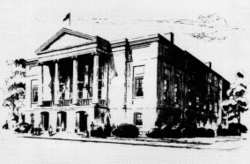Court of Appeals for the Armed ForcesIn United States v. Hiser, the court has taken a first but slim cut at telling us what UCMJ art. 117a means. Judge Maggs, writing for a unanimous court gives the BLUF. Appellant contends that the military judge abused her discretion in accepting his guilty plea to three specifications of wrongfully broadcasting intimate visual images in violation of Article 117a, Uniform Code of Military Justice (UCMJ), 10 U.S.C. § 917a (2018). According to Appellant, the providence inquiry in this case failed to establish that the victim was “identifiable” and also failed to establish a “connection to a . . . military environment” as required by Article 117a(a), UCMJ. The record, however, does not support Appellant’s contentions. Because we see no substantial basis in law or fact for questioning the plea, we affirm the judgment of the United States Army Court of Criminal Appeals (ACCA). The court takes a narrow approach because there is a a guilty plea with a stipulation and good Careful inquiry by the military judge. The court reminds us of three standards of review applicable to in a GP case: (1) A stipulation is true unless withdrawn or stricken from the record, (2) A GP gets affirmed unless there is a substantial basis in law and fact to question the providence of the plea, and (3) when interpreting a statute there is de novo review. Basically Hiser's was allowed by another Soldier video-record her involved in sexual activity on condition he didn't share it. Well, he did and and he did--take and share. He claimed on appeal that Recognizing that the new statute is "complicated," laid out in a more than "300 word" sentence, the court focuses on two of the four elements raised by Appellant. 1. What does it mean or what is required for the accused “knowingly and wrongfully broadcast[ed] . . . a visual image of sexually explicit conduct involving a person who . . . is identifiable from the . . . visual image . . . or from information displayed in connection with the . . . visual image.” Id. § 917a(a)(1)(B) (emphasis added). Second is that the accused “[knew] or reasonably should have known that the . . . visual image of sexually explicit conduct was made under circumstances in which the person depicted in the . . . visual image of sexually explicit conduct retained a reasonable expectation of privacy.” 1. What does it mean or what is required that the accused’s “conduct, under the circumstances, had a reasonably direct and palpable connection to a military mission or military environment.” The court is quick to point out that this is not a UCMJ art. 134 offense requiring proof of prejudice to good order and discipline or service discredit; although arguably GoD and the statutory language are similar? Keeping in mind this was a GP. 1. The stipulation is fact that the victim identified herself from the photo which is good enough under the first prong (citing People v. Johnson, 184 Cal. Rptr. 3d 850 (Cal. Ct. App. 2015). But also, there was viewable "information displayed in connection with the video,"--the Appellant's email address, a description of the victims relationship to him, and some corroboration through a ring and hairstyle seen in the video. The rejected the idea that the statute requires that the person be identifiable by someone in the general public other than by the victim. 2. So what is the "reasonably direct and palpable connection to a . . . military environment?" The court rejects Appellant's argument that "connection element is satisfied only if the broadcasted images at issue were “directed at servicemembers” or were “likely to reach servicemembers.”" Here the court makes the clear distinction between Appellant's guilty plea and a case litigated at trial--when reviewing a guilty plea there is no factual or legal sufficiency review involved. The court here distinguishes United States v. Wilcox, 66 M.J. 442 (C.A.A.F. 2008), which was a UCMJ art. 134, clause 1 and 2 case, and Appellant's prosecutors need not prove the additional element of GoD or SD. I doubt it helped that the stipulation of fact included that, Appellant specifically stated he uploaded the video to embarrass X., and recognized that other members of her command could see them and think “this is degrading to the U.S. military that Soldiers are uploading this kind of behavior and their intimate lives on to social media or the internet.” Appellant stipulated that there was a negative impact on the military community at Fort D. Finally, unlike the investigators in Wilcox who presumably were not affected by the controversial statements they uncovered, X was (according to the stipulated facts) “likely” to suffer “emotional distress” because of the broadcasting of the videos. Under the plain language of Article 117a(a)(4), UCMJ, nothing more is needed to establish a “direct and palpable connection to a . . . military environment.” It is possible to wonder whether this case was an appropriate vehicle for announcing some "new" law? The court also rejects several "other contentions." 1. Yes, a single factual basis may satisfy the elements of two offenses, citing Pasquantino v. United States, 544 U.S. 349, 355 (20025). 2. Arguments about "constitutional implications" of the statute and "unresolved inconsistencies between the stipulation and the video" are outside the scope of the granted issue. Air Force Court of Criminal AppealsUnited States v. Mardis. GP to sexual abuse of a child by indecent language, sexual abuse of a check by exposing his p****, sexual abuse of a child by having her touch his p****. and possessing CP. Sentenced to six years, TF, RiR, and a DD. Appellant raises two issues on appeal: (1) whether the record of trial is substantially complete, and (2) whether Appellant was subjected to a multiplicious prosecution.2 Because we agree with Appellant’s first raised issue, we need not address his second issue at this time. For the reasons discussed below, we remand the case to correct a substantial omission in the record. Army Court of Criminal AppealsJanuary 19, 2022, will hear oral argument in United States v. Cashin on the following issues. WHETHER THE MILITARY JUDGE FAILED TO PROPERLY APPLY THE LIBERAL GRANT MANDATE AND ERRED BY NOT GRANTING THE CHALLENGE FOR CAUSE FOR IMPLIED BIAS AGAINST LIEUTENANT COLONEL JF. WHETHER APPELLANT’S CONVICTION FOR OBSTRUCTION OF JUSTICE FOR CALLING HIS EX-GIRLFRIEND IS FACTUALLY AND LEGALLY INSUFFICIENT. Cheers, Phil Cave
0 Comments
Your comment will be posted after it is approved.
Leave a Reply. |
Links
CAAF -Daily Journal -Current Term Opinions ACCA AFCCA CGCCA NMCCA Joint R. App. Pro. Global MJ Reform LOC Mil. Law Army Lawyer Resources Categories
All
Archives
April 2022
|



